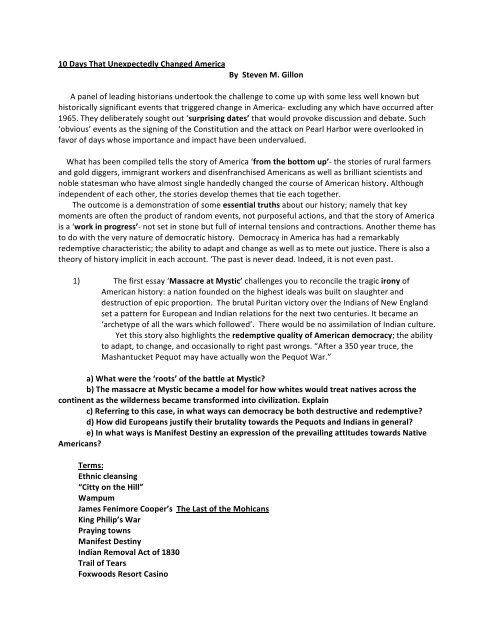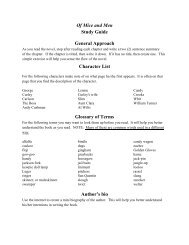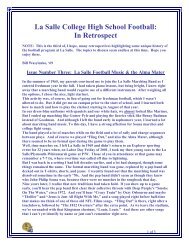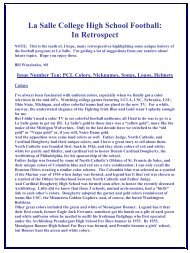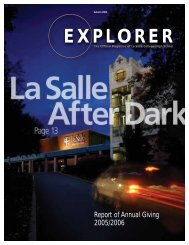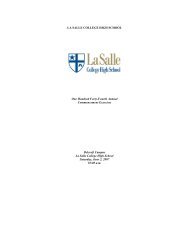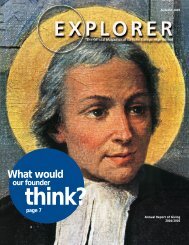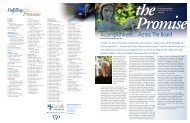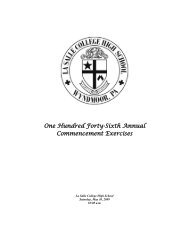10 Days That Unexpectedly Changed America
10 Days That Unexpectedly Changed America
10 Days That Unexpectedly Changed America
Create successful ePaper yourself
Turn your PDF publications into a flip-book with our unique Google optimized e-Paper software.
<strong>10</strong> <strong>Days</strong> <strong>That</strong> <strong>Unexpectedly</strong> <strong>Changed</strong> <strong>America</strong> <br />
By Steven M. Gillon <br />
<br />
A panel of leading historians undertook the challenge to come up with some less well known but <br />
historically significant events that triggered change in <strong>America</strong>‐ excluding any which have occurred after <br />
1965. They deliberately sought out ‘surprising dates’ that would provoke discussion and debate. Such <br />
‘obvious’ events as the signing of the Constitution and the attack on Pearl Harbor were overlooked in <br />
favor of days whose importance and impact have been undervalued. <br />
<br />
What has been compiled tells the story of <strong>America</strong> ‘from the bottom up’‐ the stories of rural farmers <br />
and gold diggers, immigrant workers and disenfranchised <strong>America</strong>ns as well as brilliant scientists and <br />
noble statesman who have almost single handedly changed the course of <strong>America</strong>n history. Although <br />
independent of each other, the stories develop themes that tie each together. <br />
The outcome is a demonstration of some essential truths about our history; namely that key <br />
moments are often the product of random events, not purposeful actions, and that the story of <strong>America</strong> <br />
is a ‘work in progress’‐ not set in stone but full of internal tensions and contractions. Another theme has <br />
to do with the very nature of democratic history. Democracy in <strong>America</strong> has had a remarkably <br />
redemptive characteristic; the ability to adapt and change as well as to mete out justice. There is also a <br />
theory of history implicit in each account. ‘The past is never dead. Indeed, it is not even past. <br />
<br />
1) The first essay ‘Massacre at Mystic’ challenges you to reconcile the tragic irony of <br />
<strong>America</strong>n history: a nation founded on the highest ideals was built on slaughter and <br />
destruction of epic proportion. The brutal Puritan victory over the Indians of New England <br />
set a pattern for European and Indian relations for the next two centuries. It became an <br />
‘archetype of all the wars which followed’. There would be no assimilation of Indian culture. <br />
Yet this story also highlights the redemptive quality of <strong>America</strong>n democracy; the ability <br />
to adapt, to change, and occasionally to right past wrongs. “After a 350 year truce, the <br />
Mashantucket Pequot may have actually won the Pequot War.” <br />
<br />
a) What were the ‘roots’ of the battle at Mystic? <br />
b) The massacre at Mystic became a model for how whites would treat natives across the <br />
continent as the wilderness became transformed into civilization. Explain <br />
c) Referring to this case, in what ways can democracy be both destructive and redemptive? <br />
d) How did Europeans justify their brutality towards the Pequots and Indians in general? <br />
e) In what ways is Manifest Destiny an expression of the prevailing attitudes towards Native <br />
<strong>America</strong>ns? <br />
<br />
Terms: <br />
Ethnic cleansing <br />
“Citty on the Hill” <br />
Wampum <br />
James Fenimore Cooper’s The Last of the Mohicans <br />
King Philip’s War <br />
Praying towns <br />
Manifest Destiny <br />
Indian Removal Act of 1830 <br />
Trail of Tears <br />
Foxwoods Resort Casino
<br />
<br />
2) The second essay raises an interesting question about cause and effect in history. ‘Would <br />
the founding fathers have adopted a different constitution had Daniel Shays not led his <br />
ragtag army in rebellion against Massachusetts authorities?” It also highlights a critical <br />
tension in defining democracy; how to balance the demands and fears of democracy with <br />
the need to preserve social order? <br />
In effect Daniel Shays exposed the fragility and fears of the democratic experiment. <br />
James Madison declared the rebellion in Massachusetts to be a ‘warning’. Ironically, the <br />
<strong>America</strong>n Revolution, which was intended to limit the powers of government instead created an <br />
even stronger central authority in the Constitution. The fears of ‘mobocracy’ shaped the <br />
founding fathers’ discussion over the new constitution and the document reflects the essential <br />
conservative nature of the group. <br />
Since first exposed by a man so shadowy that historians do not even know what he looks <br />
like, the gap between the ideals of democracy and the realities of power remain open as we <br />
debate the size and scope of our government today. <br />
Is big government the problem or is it the solution? The Reagan Revolution and the rise of <br />
Rush Limbaugh, and the election of President Obama have breathed life into the essential over <br />
which Shays Rebellion took place. ‘The past is never dead. It’s not even past.” <br />
<br />
a) Daniel Shays has become known to historians as ‘the godfather’ of the United States <br />
Constitution. Explain how he and his followers ‘lost the rebellion but won the peace’. <br />
<br />
b) Explain how the barter system worked in colonial <strong>America</strong>. Why did the system come <br />
crashing down after the Treaty of Paris of 1783? <br />
c) Identify the two very different views of the legacy of the <strong>America</strong>n Revolution and the <br />
true nature of democratic government held by the Shaysites on the one hand and the <br />
conservatives on the other. Which has ‘won’out? <br />
d) What role did George Washington play in the success of the Constitutional Convention? <br />
e) What were the elements built into the constitution by the founding fathers to protect the <br />
fledgling democracy against radicalism? <br />
f) Explain the gap between the ideals of the revolution expressed in the Articles of <br />
Confederation and the realities of power enshrined in the Constitution. What measure <br />
were put into the body of the Constitution to control the rise of radicalism? <br />
g) In what ways could southerners during the Civil War claim a common heritage with Daniel <br />
Shays to support states rights and secession? <br />
Terms: <br />
Treaty of Paris of 1783 <br />
Articles of Confederation <br />
Regulators <br />
Meritocracy <br />
The Federalist Papers (Federalist #51) <br />
Federalists <br />
Anti‐Federalists <br />
Virginia Resolves <br />
demagogue <br />
Huey Long <br />
Joseph McCarthy
3) “Like Argos of the ancient times, I’ll leave this modern Greece; I’m bound to California mines <br />
to find the golden fleece.” <br />
The third story tells the incredible tale of the largest mass movement of people in world <br />
history. “Neither the Crusades nor Alexander’s expedition to India can equal this emigration <br />
to California.” Once the discovery of gold in California was officially declared by President <br />
Polk in his State of the Union Address on December 5 th , 1848, “The world rushed in.” <br />
California became a place that no other country could imitate with its diversity of race, <br />
religion, color, language, government, condition, size, strength and morals. <strong>America</strong>n and world <br />
history were changed forever; in some ways beneficial, in other ways not so. <br />
<br />
a) What were the political, economic, social and environmental effects of the California gold <br />
rush. <br />
b) How did these effects shape and define what it meant (and means) to be an <strong>America</strong>n?. <br />
c) Evaluate the beneficial and negative effects of the consequences of the gold rush. <br />
d) Explain why the discovery of gold in California and the end of the Mexican‐<strong>America</strong>n War <br />
can be considered one of the most remarkable coincidences in <strong>America</strong>n History. <br />
e) How was the forging of a new cosmopolitan culture in California a continuation of a <br />
familiar pattern of <strong>America</strong>n racism and discrimination? <br />
f) How did the discovery of gold transform the <strong>America</strong>n Dream in contradiction to the <br />
Puritan and Jeffersonian notions of success? <br />
Terms: <br />
Sutter’s Fort <br />
<strong>America</strong>n Dream <br />
Mexican‐<strong>America</strong>n War <br />
49ers <br />
Overland Trail <br />
Oregon Trail <br />
Missouri Compromise <br />
Wilmot Proviso <br />
Compromise of 1850 <br />
Popular sovereignty <br />
Fugitive Slave Act <br />
Kansas‐Nebraska Act <br />
Uncle Tom’s Cabin <br />
Dred Scott Decision <br />
<br />
<br />
<br />
<br />
<br />
<br />
<br />
<br />
<br />
<br />
<br />
<br />
4) In one of the most exciting ‘what ifs’ in the history of the world, when Corporal Barton W. Mitchell <br />
of the 27 th Indiana Regiment laid his head under the shade of a tree in a meadow east of Frederick, <br />
Maryland and found a bulky envelope with three cigars, the course of the Civil War and with it the <br />
emancipation of slavery and the future of the <strong>America</strong>n experiment in democracy turned completely <br />
around. How would <strong>America</strong>n history have unfolded if ……….? <br />
The fourth essay explorers the effects of finding General Robert E. Lee’s Order #191 which allowed <br />
the slow‐ footed General McClellan to defeat the onrushing, if outnumbered Confederate army at the <br />
Battle of Antietam‐ forever dissuading the British from recognizing the Confederacy and deflating the <br />
mounting Northern peace movement. <br />
In the Battle of Antietam on September 17 th , 1862, in which four times as many <strong>America</strong>ns died on <br />
the battlefield than were killed in the D‐Day invasion of Normandy, the shape of the <strong>America</strong>n nation <br />
took form. The victory, even though it was rather tentative, gave impetus to the birth of modern <br />
<strong>America</strong>. <br />
<br />
a) What were the elements of the modern <strong>America</strong>n nation which took shape as a result of the <br />
Union victory in the Civil war and how is the legacy of Antietam alive today in both South and <br />
North? <br />
b) What were the advantages and relative disadvantages of the Union and Confederacy in the <br />
Civil War? <br />
c) How did each side justify the war? How did Lincoln frame the issues upon which he sent <br />
nearly 600,000 men to their death? <br />
d) How did the nature of the civil war change as a result of the ‘victory’ at Antietam? <br />
e) How did the Emancipation Proclamation transform the war into a struggle over the meaning <br />
of ‘freedom’? How was the issuance of the Proclamation related to the Battle of Antietam? <br />
<br />
<br />
Terms: <br />
Copperheads <br />
Emancipation Proclamation <br />
Total war <br />
Sherman’s March to the Sea <br />
Appomattox Truce <br />
13 th Amendment <br />
14 th Amendment <br />
15 th Amendment <br />
<br />
<br />
<br />
<br />
<br />
<br />
<br />
<br />
<br />
<br />
<br />
<br />
<br />
<br />
5) Chapter five is the woeful saga of working class democracy in <strong>America</strong> ‐ its rise and death in <br />
Homestead, Pennsylvania on July 6 th , 1892. One of many ever present tensions in <strong>America</strong>n democracy <br />
took on yet another form; the individual (and collective) rights of workers versus the public good. While <br />
workers joined unions and looked to their government to protect their quality of life, management <br />
looked to government to protect the property rights of business so as to allow prosperity to prevail. <br />
Sometimes it takes decades to discern the significance of a historical event. <strong>That</strong> was not the case <br />
at the Homestead Steel strike. As the brilliance of the second industrial revolution grew brighter, the <br />
already strong alliance between big business and the power of the state doomed any hope that workers <br />
could ‘own’ the factories where they toiled 12 hours a day, seven days a week. The growth of <strong>America</strong>’s <br />
industrial supremacy came at a great cost; the alternative vision of working class democracy was <br />
doomed. <br />
a) ‘The shots fired at Homestead, like the shots fired at Lexington, were heard around the <br />
world…as were the shots fired at Mystic, Connecticut, Springfield, Massachusetts, and the <br />
Battle of Antietam, and no less than the words proclaimed by President Polk on December 5 th , <br />
1848.’ Explain <br />
b) What were the opposing visions of the meaning of democracy articulated by <strong>America</strong>n workers <br />
and industrial owners. How are these ‘visions’ of democracy similar to and different from those <br />
articulated by Daniel Shays and the Founding Fathers? <br />
c) What were the consequences of the coming of the ‘second industrial revolution’ for <strong>America</strong>n <br />
workers. <br />
d) Describe the relationship between big business and government? What was the affect on <br />
organized labor? How did this relationship influence the future of industry in <strong>America</strong>? <br />
<br />
<br />
Terms: <br />
Terrence Powderly <br />
Haymarket Square Riot <br />
Andrew Carnegie <br />
Henry Clay Frick <br />
First and Second Industrial Revolutions <br />
Frederick W. Taylor <br />
‘iron clad’ contracts <br />
Lockout <br />
Coxey’s Army <br />
Pullman Strike <br />
Eugene Debs <br />
<br />
<br />
<br />
<br />
<br />
<br />
<br />
<br />
<br />
6) The death of William McKinley signaled the passing of an era and the dawn of the “<strong>America</strong>n <br />
century”. As <strong>America</strong> grew into an industrial giant, its rural, small town heritage was challenged by <br />
new forces ‐a swelling population speaking different languages and worshipping different gods, <br />
crime, congestion, cultural conflict and a growing gap between the rich and poor. Many looked to <br />
the government to ‘become an engine for social betterment; while others firmly stood on the <br />
ground of social ‘conservatism’. <br />
The sixth essay analyzes the transition from rural and small town to industrial and urban <br />
<strong>America</strong> through the unfortunate assassination of the symbol of the past century‐William McKinley‐ and <br />
the coming to power of the first symbol of the modern <strong>America</strong>n President, Theodore Roosevelt; the <br />
first President to ride in an automobile, fly in an airplane and be submerged in a submarine. <br />
The central questions of the day‐ excessive power of corporate wealth, the dangers of growing <br />
labor radicalism, environmental degradation, and the emergence of <strong>America</strong> as a world power‐ needed <br />
to be addressed in a different way. No less than today, <strong>America</strong>ns had a certain fear about their future. <br />
TR’s sense of Presidential power and his spirited leadership quelled those fears and shaped <strong>America</strong>n <br />
society and politics for the rest of the 20 th century, helping <strong>America</strong>ns make the transition from a rural <br />
republic to a world power. <br />
<br />
a) What were the elements of Theodore Roosevelt’s leadership and politics which have made him <br />
the first truly ‘modern President “ and one of the most popular and influential <strong>America</strong>n Presidents? <br />
Does he deserve his place on Mt. Rushmore? <br />
b) In what ways did Roosevelt’s ‘accidental Presidency’ change the course of the century? <br />
c) In what ways did TR’s presidential leadership foreshadow the New Deal and the Greta Society? <br />
d) How did TR’s presidency answer the questions about the size and scope of government that were <br />
raised earlier by Daniel Shays? <br />
e) Explain how both Republicans and Democrats in the modern era can embrace Theodore Roosevelt <br />
as the spokesman for their respective philosophies? <br />
Terms: <br />
<strong>America</strong>n Century <br />
Jacob Riis <br />
Protective tariff <br />
Anarchism <br />
Conservatism <br />
Laissez‐faire liberalism <br />
‘bully pulpit’ <br />
‘stewardship’ theory of Presidential power <br />
Progressive Movement <br />
JP Morgan <br />
Northern Securities Case <br />
‘good’ trusts / ‘bad’ trusts <br />
‘square deal’ <br />
Conservation movement <br />
Alfred T. Mahan <br />
Roosevelt Corollary to Monroe Doctrine <br />
Imperialism <br />
Herbert Croly <br />
Election of 1912 <br />
7) Curiously, the next essay about the infamous ‘monkey trial’ represents a turning point in <br />
<strong>America</strong>n history not for what it resolved, but for what it revealed; a deep cultural fault line in <br />
<strong>America</strong>n society. The Scopes Trial of 1925 represented the first skirmish in an ongoing culture war <br />
that continues to shape <strong>America</strong>n politics in the current age. <br />
The fault line of the 1920’s was between the values of an older rural past and a rising urban <br />
culture; between doubter and devout, between elite opinion and common belief and the public <br />
schools became the battleground between science and religion. <br />
The ‘most amazing courtroom scene in Anglo‐<strong>America</strong>n history’ not only put Dayton, Ohio on <br />
the map but swept Dover, Pennsylvania into the controversy. Along the way, abortion rights, gay <br />
rights and prayer in the schools became the targets. “The past is never dead. Indeed, it is not even <br />
past.” Who is to be included and who is to excluded in the <strong>America</strong>n Dream? <br />
<br />
a) What are the sources of the deep divisions of democratic culture in the 1920’s? What are the <br />
issues today and how will they be reconciled? <br />
b) What were the significant changes that appeared in <strong>America</strong>n society in the 1920’s? What role <br />
did the automobile play in bringing about these changes in <strong>America</strong>n society? <br />
c) In what ways did the 18 th Amendment represent an effort to define and defend ‘traditional’ <br />
<strong>America</strong>n values and what it means to be an <strong>America</strong>n? <br />
d) What were the underlying suspicions of democracy which the Scopes Trial exposed? What did <br />
HL Mencken mean when he said that ‘Civilized life is not possible under democracy’? <br />
e) What elements of the arguments over the Constitution which Shays Rebellion first exposed <br />
were repeated in the debate over teaching evolution? Summarize both points of view. <br />
f) In what ways were the debates over evolution a repeat of the ongoing fault line in democracy <br />
between the struggle for the rights of the minority against majority rule ? <br />
Terms: <br />
National culture <br />
Prohibition/18 th Amendment <br />
Ku Klux Klan <br />
Darwinism/ Theory of Evolution <br />
Religious Fundamentalism <br />
HL Mencken <br />
ACLU <br />
Butler Act <br />
Cross of Gold Speech <br />
Creation science <br />
Intelligent design <br />
<br />
<br />
<br />
<br />
<br />
<br />
<br />
<br />
<br />
<br />
<br />
8) It has been recorded that England was saved by the short‐sightedness of Napoleon who <br />
turned away an <strong>America</strong>n inventor who offered to build a fleet of steamships that could be used <br />
without sails and despite uncertain weather, transport his army across the Channel. “Had Napoleon <br />
shown more imagination…the history of the world would have taken a very different course.” <br />
The letter written by Albert Einstein, the ‘Pope of Physics’ at the request of Leo Silard, the <br />
eccentric Hungarian born physicist, to persuade FDR to initiate the Manhattan Project, may be <br />
one of the most important in world history. Sometimes something as simple as a letter can change <br />
the course of history. Unlike Napoleon, FDR was persuaded to develop and use science and new <br />
technology to defeat the greatest threat to world peace at the time‐Hitler and the forces of the <br />
Axis powers. <br />
<br />
a) What was the purpose and content of the letter and how did it change the course of <br />
history both directly and indirectly. <br />
Use your imagination (one of the tools of the historian) to speculate how the present <br />
might have differed had the letter not been written. <br />
b) Explain what Leo Szilard meant when he said…’we saw the flashes….{and} that night <br />
there was little doubt that the world was headed for grief?” <br />
c) What were the steps which Hitler took in leading the world into WWII? To what degree <br />
was the League of Nations at fault? To what degree was the US at fault? Could this have <br />
been avoided? <br />
d) Why did Einstein leave Germany? Why did he choose to settle in the US? <br />
e) Why was Einstein’s equation E=MC2 considered ‘one of the greatest achievements in the <br />
history of the world’? What were the ’horrifying’ ramifications of the theory? <br />
f) “I am become Death, destroyer of worlds.” What did Dr. Oppenheimer mean by this <br />
quote? Did all military planners and scientists agree about whether to use the atomic <br />
bomb? Summarize both sides of the debate. What was President Truman’s opinion? <br />
g) Why did Einstein consider his letter to FDR as ‘one of the greatest mistakes of my life’? <br />
h) What impact did the development of the nuclear weapon have on <strong>America</strong>n society and <br />
culture and its relationship with the outside world? <br />
i) According to President Eisenhower, what were the real costs of the cold war? <br />
<br />
Terms: <br />
Yalta Conference <br />
Potsdam Conference <br />
Nuclear fission <br />
The Manhattan Project <br />
Leslie Groves <br />
J. Robert Oppenheimer <br />
MADD <br />
Sen. Joseph McCarthy <br />
‘Big Science” <br />
Interstate highway system <br />
‘military – industrial complex’ <br />
Cold war <br />
Peace Declaration <br />
<br />
9) By 1955 the glossy image of conformity and consensus of <strong>America</strong>n middle‐class culture were <br />
becoming deeply reinforced by television and mass media. There was a shared national culture <br />
where no one was ever sick, no one was ever poor, families were intact, men worked during the day <br />
and women stayed at home, and African –<strong>America</strong>ns were invisible. <br />
Elvis Presley’s performance on the Ed Sullivan Show on September 9 th , 1955 symbolized the <br />
emergence of a new youth culture that would transform <strong>America</strong>n culture and politics of the <br />
modern era. No longer would they wear the same style clothing, watch the same TV shows, listen <br />
to the same music and admire the same people. <br />
Elvis created a whole new set of cultural options for young people, stirred a mixing of the black <br />
and white races and defined an entire generation‐the Elvis generation. He gave voice to a youth <br />
revolt that touched off a social revolution in the 1960’s and 70’s that would soon turn to political <br />
revolution. <br />
<br />
a) What did John Lennon mean when he said, “Before Elvis there was nothing?” Why would <br />
Leonard Bernstein call Elvis Presley ‘the greatest cultural force in the 20 th century’? <br />
<br />
b) What were the elements of teenage culture as it developed in the US in the 1950’s. How did <br />
these elements clash with the emphasis on consensus and conformity? In what way was <br />
Elvis Presley the ‘Trojan Horse’ of the new youth culture? <br />
<br />
<br />
c) Why and how did Elvis Presley emerge as such a huge star in the mid‐1950’s? Did all elements <br />
of <strong>America</strong>n society welcome Elvis’ rise to stardom? What position did the Catholic Church take <br />
in regards to Elvis’ popularity? <br />
<br />
<br />
<br />
<br />
Terms: <br />
Middle class culture <br />
Emmitt Till <br />
Kinsey Report <br />
‘race music’ <br />
Brown v Board of Education <br />
“with all deliberate speed” <br />
Southern Manifesto of 1956 <br />
Dick Clark’s <strong>America</strong>n Bandstand <br />
Elvis Generation <br />
<br />
<br />
<br />
<br />
<br />
<br />
<br />
<br />
<strong>10</strong>) The campaign to register blacks throughout the South in 1964, known as the Freedom <br />
Summer program, attracted Michael Schwerner , Andrew Goodman and James Earl Chaney to the <br />
‘heart of darkness ‘ of rural Mississippi. Their presence was like a foreign invasion to many <br />
Southern whites who treated them accordingly. <br />
On June 21 st 1964 (Father’s day) one of the organizers, Robert Moses’ prediction about <br />
what it would take to succeed tragically came true. It would take the involvement ( and the death) <br />
of white students to focus the attention of the nation and the world on segregation and the plight <br />
of the black man. “They will bring the rest of the country with them”. The painful reality was that <br />
the press and public cared only when a white person was killed. <br />
The reluctant martyrs of Freedom Summer and the odd coincidence of a Hollywood movie <br />
combined to permanently change race relations in the South, initiate a new and more radical <br />
phase of the ‘black revolution’ and ironically, strengthen the foundation of democracy in <strong>America</strong>. <br />
<br />
a) What did William Faulkner mean when he said, “The past is never dead. It’s not even past”. <br />
How does this relate to the tragedy of Freedom Summer? <br />
b) In what ways did the murders of these young idealist mark the dividing line between the hope <br />
and idealism of the Civil Rights Movement of the early 1960’s and the discord and dissent <br />
that followed; ‘ the breeding ground for the social turmoil of the rest of the decade.’ <br />
c) What were the combination of forces which began to undermine racial segregation in the <br />
South prior to Freedom Summer? <br />
d) What were the various methods which were used to keep African <strong>America</strong>ns disenfranchised <br />
in the South, especially in Mississippi? <br />
e) What effect did Robert Moses’ strategy to recruit white students have on blacks involved in <br />
the Civil Rights Movement in the South? <br />
f) What affect did the Gulf of Tonkin Crisis have on the future success of the civil rights <br />
movement and the motives of liberal white students to support it? <br />
g) What affect did Hollywood have on the drive to bring justice to the murderers of the three <br />
civil rights workers and other unsolved cases of the period? <br />
h) How does this dark episode in <strong>America</strong>n history underscore the redemptive process of <br />
democracy ? <br />
i) Carefully explain President Lyndon Johnson’s role, attitude and motives toward the passage of <br />
the Voting Rights Act and the debate in the Democratic National Convention in Atlantic City <br />
in 1964. Did all accept the terms of the so‐called Atlantic City Compromise? <br />
<br />
Terms: <br />
Greensboro Boys <br />
CORE <br />
SNCC <br />
‘freedom riders’ <br />
‘poll tax’ <br />
Robert Moses <br />
COFO <br />
16 th St Baptist Church in Birmingham, Ala <br />
White Knights <br />
MFDP <br />
APWR <br />
Atlantic City compromise <br />
“Second reconstruction”
Edmund Pettus Bridge <br />
Voting Rights Act of 1965 <br />
Civil Rights Act of 1966 <br />
Mississippi Burning <br />
Jerry Mitchell <br />
26th Amendment <br />
<br />
<br />
<br />
<br />
<br />
<br />


